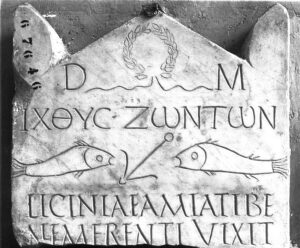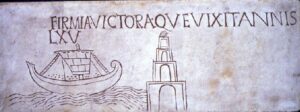Excerpt from: Estelle Shohet Brettman, Vaults of Memory: The Roman Jewish Catacombs and their Context in the Ancient Mediterranean World, with Amy K. Hirschfeld, Florence Wolsky, & Jessica Dello Russo. Boston: International Catacomb Society, 1991-2017 (rev. 2024).
The ancient Greeks and Romans believed that dolphins, hippocampuses, and their close relatives hippogriffs (which, in turn, are related to griffins), as well as tritons and boats, carried the deceased over perilous waters to the Elysian Fields.
The friendly, ministering dolphin, the fabulous hippocamp, and the triton, all part of the retinue of Poseidon (the Roman Neptune), were credited with saving mortals from drowning or guiding them through uncharted seas. Often associated with the Marine Venus or Aphrodite (Venus Anadyomene) who was born of the sea foam, the dolphin became a favored symbol of salvation and resurrection as well as that of the sea itself.
Greek myths tell of music-loving dolphins rescuing the famed musician Arion with his lyre from his pirate abductors or bearing Taras to Southern Italy to found the Greek colony of Tarentum (today's Taranto). Hence these denizens of the deep became motifs for deliverance, bearing the trident, the anchor, and the cross.
In early Christian iconographic art, the story of Jonah and the "great fish" (Jonah 1:17; 2:10) appeared as one of the most popular Biblical allegories of deliverance and redemption. Jonah's emergence from the fish's belly after three days was a natural analogy for the resurrection of Jesus Christ after three days in the tomb.
From the most ancient times, ships were pictured as conveyances of the dead to the next world. In Christian art, the ship often represented the Church, and the mast, the cross.
Fig. 1. Vaults catalogue, p. 27, fig. 122. From the period of the Middle Bronze Age (second millennium BCE), the swift, intelligent dolphin was represented figuratively, as seen in an example of Greek intaglio, mottled Jasper scaraboid with streaks of chalcedony of the 5th c. B.C.E. Boston Museum of Fine Arts.
Fig. 2. Vaults catalogue, p. 27, fig. 123. Augustus as Neptune: In this intaglio, Augustus, shown as the god Neptune, his chariot drawn by hippocampuses, calms the stormy seas with his trident as a triton rises from the sea before him, and a dolphin follows. The victory of Augustus at the Battle of Actium (31 BCE) may have been allegorized in this gem. Milky sard intaglio with owner's name, Popilius Albanus, inscribed on the upper right of the gem from Hadrumentum, Tunis, now in the Boston Museum of Fine Arts.
Fig. 3. Vaults catalogue, p. 27, fig. 124. Dolphin Wound around a Trident: The dolphin with the trefoil tail entwined around a trident was represented in catacombs of the Jews and Christians in Rome. The trident, an attribute connoting the power of the elements and their personifications in many ancient cultures, symbolized the scepter of Poseidon. Vault painting in a chamber in the upper catacomb of Villa Torlonia, Rome.
Fig. 4. Vaults catalogue, p. 27, fig. 125. Two Emblems of the Sea: In Christian imagery, the trident evolved into the anchor and the cross. As the bearer of souls across the sea, the dolphin became a metaphor for Jesus Christ, carrying souls to heaven. Wall painting of the Jonah cycle, Catacombs of S. Sebastiano, Rome.
Fig. 5. A Surprising Combination: On an elegantly carved stele dedicated to the chaste, well-remembered Licinia, a wreath - often an emblem of victory in ancient art - crowns the gable flanked by acroteria. Two fish swim toward an anchor, above which is inscribed in Greek IXOYC ZWNTWN, interpreted to mean "Jesus Christ, Son of God, Savior of the Living ''.[1] Each letter of the unexpected pagan formula "D. M.", standing for Dis Manibus, the invocation to the god of the shades of the dead, flanks the wreath on the upper part of the stone. Originally from the Vatican Necropolis and probably dating to the third century CE.
Fig. 6. Vaults catalogue, p. 27, fig. 126. Anchor in Transition. Inscribed on a fragmentary epitaph, fish facing each other bear in their mouths a cross-like anchor, reminiscent of the Egyptian ankh or crux ansata. Other curious and suggestive symbols, including one which incorporates the cross, are carved on the right side of the stone. Rome, Catacomb of Domitilla, Rome.
Fig. 7. Vaults catalogue, p. 27, fig. 127. Dolphin bearing a cross: Limestone relief from a Coptic cemetery of Armant, Egypt, 4th-5th centuries CE. Paris, Musée du Louvre.
Fig. 8. A Dolphin Assists an Explorer of the Aegean: Taras rides off on the back of his seafaring friend to found the Greek colony of Tarentum on the boot of southern Italy. His shield bears the emblem of another popular psychopomp, the fabled winged horse Pegasus. Silver Italic stater, ca. 334-302 BCE.
Fig. 9. Putti Speed over the Waves with Dolphins and Hippogrifs: A winged charioteer spurs on the two bounding dolphins who propel his two-wheeled vehicle, a biga. Late first century CE painting on a pillar in the atrium of the House of the Vettii in Pompeii.
Fig. 10. Vaults catalogue, p. 27, fig. 127. Half horse, half sea creature, the hippocamp frolics with members of another group of marine psychopomps, the dolphin. The impressionistic, cursory style of painting is very apparent in this chamber (the palette limited mostly to earth tones), and yet the particular characteristics of each animal are expressed with witty vivacity. Vault painting in a chamber in the Catacomb of Vigna Randanini, Rome.
Fig. 11. Vaults catalogue, p. 27, fig. 129. Jonah and the "Whale": In this illustration of the Biblical narrative (Jonah 1:15), Jonah is tossed from the canopied bark toward the impatiently waiting elongated sea-monster, a hybrid species bearing the head of a Greek keto with flames shooting out from his jaws and a trident-like tripartite tail. The unusual addition of a golden-yellow pigment lends a lively quality to this vault painting. Chamber of the "Due Ingressi" (two entrances) in the Catacombs of Saints Marcellinus and Peter, Rome.
Fig. 12. A Trip down the River: Carved on a sarcophagus of the third century CE, a staunch Roman citizen sites in splendor on a canopied vessel which is towed to an unknown future by a biga along a canal of the Tiber River, perhaps imagined here as the mythological River Styx. He is accompanied by buxom, reclining female companions, who appear to hold vestiges of cornucopias in their left hands, indicating that they might be representations of Abbondanza, or Plenty. Marble sarcophagus, Gardens of Villa Colonna, Rome.
Fig. 13. The Waiting Ship: An evocative graffito of a ship with sails and oars is incised on the plastered closure of a badly vandalized loculus-type opening in a gallery of the lower catacomb of Villa Torlonia, Rome.
Fig. 14. Hail or Farewell: On a rather cramped skiff, the oarsman has either deposited his cargo, an orant, in a blissful but rather bleak paradise, or is being welcomed by her. Both are attired in Greek garb. The scene is in the tradition of the character of Herefhaf, the Egyptian ferryman, as well as his Sumerian counterpart, and Charon, the Greek helmsman. It may serve as a graphic visualization of the passage from the 18th Dynasty Spell 99, "Bring me the ferry boat, attach for me the tow rope, in peace, in peace.".[2] Greco-Roman sandy limestone funerary stele from Kom Abou Billou, Terenouthis, Egypt.
Fig. 15. Vaults catalogue, p. 27, fig. 131. Safe Harbor: The 65-year old Firmia Victora's ship approaches the haven of salvation guided by the beacons of a four-story lighthouse. Third century CE marble epitaph originally from the Coemeterium Jordanorum ad S. Alexandrum, Rome.
Here Sorrow Ceases: In front of a pagan tomb, a black and white mosaic - typical of the Roman Imperial period - bears a heartening legend, "here sorrow ceases". Depicted on the mosaic are two boats approaching a lighthouse, or tranquility. Mosaic from the second-fourth centuries CE, Isola Sacra, Fiumicino.
[1] P. Testini, Archeologia Cristiana, 2d. ed. (Bari: Edipuglia, 1980), p. 436.
[2] Thomas G. Allen, The Book of the Dead (Chicago: Oriental Institute of the University of Chicago, 1984).








